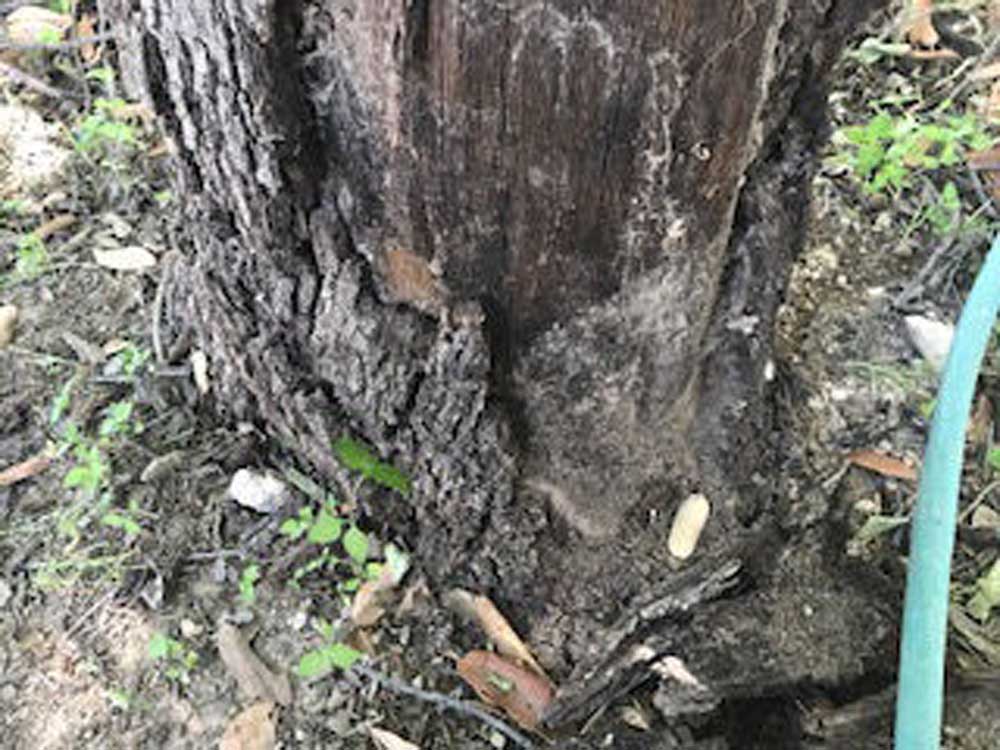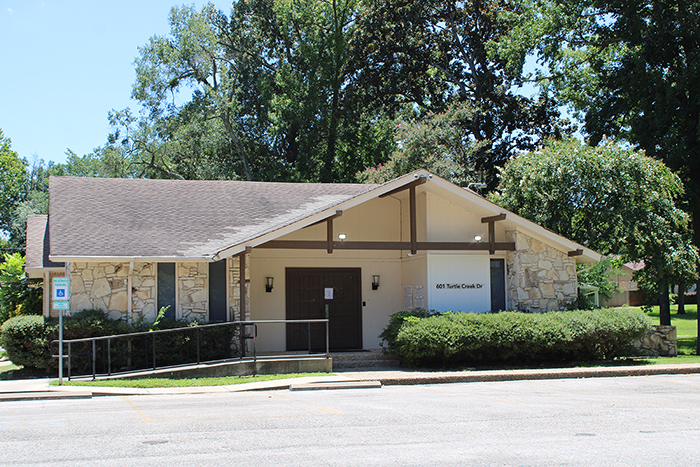Sperry gives advice on quickly dying trees, weedkillers, insects and more
Published 5:00 am Sunday, April 28, 2024

- Lower trunk of a Mexican white oak likely affected by radial shake. (Contributed Photo)
Dear Neil: I’ve lost large chunks of bark off my Mexican white oak in just six weeks. It is without leaves. It’s a great shade tree on the west side of my kitchen. What might have caused that?
It’s a bit hard to determine just from the photos, but I’d lean strongly toward the same radial shake that has impacted so many thousands of other oaks across Texas since the great cold spell of February 2021. Bark was split away from the trees’ trunks, and when that happened the phloem was interrupted. That’s the cylinder of tissue that carries sugars down from the leaves to the roots. Without that nourishment the roots die. You can see that the internal wood of your tree’s trunk has been dead for some period of time as judged by its color and its cracking. Mexican white oaks are not winter hardy to the kind of temperatures much of Texas encountered during that period. It’s odd that it would have waited the extra years to die from that cold, but the damage must just have become severe enough to cause the bark to separate completely. Sadly, it’s time for a different type of tree.
Trending
Dear Neil: This oak tree has been pruned recently and we noticed that the limbs are attaching to other limbs. Is this unusual?
This is a sort of natural grafting, and it happens every once in a while. It’s usually because two branches grow across one another. As their tissues develop, they unify. It can certainly happen to more than one pair of branches at a time. It’s usually not a good thing because moisture and fallen leaves will get trapped in the cracks. Prune one of them off if you can reach it before they become firmly unified, but not to the point of disfiguring the tree.
Dear Neil: Why would native hickory trees have died? They were good last year. Many just never leafed out this spring.
That’s not much to go on. I’d suggest you think back to last fall and whether any damage was done by extended drought. Perhaps a weedkiller was inappropriately applied. I don’t believe an insect or disease would have been active over the winter. Contact your county Extension office to see if they can offer some help.
Dear Neil: Our trees are covered with fat, black, furry caterpillars that are devouring the leaves. How much longer will they be around? Should we be concerned about our trees? Do they turn into butterflies?
Without a photo and an ace entomologist on hand, we are going to have to assume they are a spring insect. They usually run their course after a few weeks. If you’re concerned, you could apply B.t. or almost any general-purpose insecticide to stop them quickly. Your trees should re-leaf soon thereafter.
Trending
Dear Neil: Is there a weedkiller I can use in rock beds, between sidewalk pavers, etc. that won’t damage plants, shrubs or turf that is 1 to 5 ft. away from where I’ll be applying it?
That is the perfect place for a glyphosate-only herbicide. They are active only above ground – inactivated when they come into contact with the soil. Some people are convinced that they are harmful and prefer to use a labeled form of vinegar, but I am not willing to recommend vinegar because the control it offers is so short-term and variable. I’m talking about using a pump-type spray bottle of glyphosate and applying it just to the weeds.
Dear Neil: We have had a wonderful redbud tree, but it seemed to die rather quickly. The trunk has a split and I saw a beetle. Is it safe to plant another tree in this spot? Should I treat the soil to prevent more of this pest?
I’m not sure what might have killed your redbud, but it looks like there was a problem near the soil line. If this was a grafted “improved” variety, it may be that the graft union deteriorated. The beetle you photographed is a tree borer, and while it was in its larval form it tunneled through the trunk. You can see what are probably exit holes near the ground line. There is not much spraying you can do to prevent borers of this type. Start with a different species. Most others won’t be susceptible.
Dear Neil: Our live oak keeps putting up the roots in our yard. Sprouts grow up from them. It all makes it difficult to grow flowers there, and as you can see, the grass isn’t thriving, either. What can we do?
Live oaks vary from one tree to the next. One of the ways in which they vary is in the number of surface roots and root sprouts they have. These in your photo are especially obnoxious because of their size. Unfortunately, you can’t dip a chain saw into the ground because soil will dull it instantly. About the only remedy would be to dig around these big root burls and cut them out with an axe. Hopefully there aren’t too many of them. Some people solve this by establishing large beds and planting groundcovers just to camouflage the surface roots.
I can’t tell if your lawn is hurting because of excessive shade, or if take all root rot, the early spring fungus, is present. Hopefully, either way, you can rectify the situation.
Dear Neil: Two years ago, I bought two very small Vitex plants in small pots. I planted them in our flowerbed, hoping they would cover unsightly electrical equipment. They are no longer small, and I’m concerned the electric company will be coming after me. Should I take them out? (The grass is artificial.)
Before you give up on them entirely, why don’t you consider using lopping shears to raise their canopies? That’s how we convert a crape myrtle into a tree, for example. Remove the bottom-most branch off each plant step back and look to see how the results are. If you see another branch that needs to be removed, do so. Step back and look again and continue the trimming until you like the looks. You can do more trimming next winter while they’re dormant.






